You are using an out of date browser. It may not display this or other websites correctly.
You should upgrade or use an alternative browser.
You should upgrade or use an alternative browser.
Bandits and Generals - The 20th Century and Beyond
- Thread starter General Mosh
- Start date
AlexG
Banned
I'm having trouble believing that Mexican troops would be well trained and well equipped enough to perform such a rescue. I don't doubt their personal bravery but it's very unlikely that someone would plan this rescue, gather 100,000 soldiers from somewhere and launch a successful attack through enemy lines deep enough to link up with the sorrounded forces. It's very Romantic and lovely but it seems like wishful thinking. That said I do enjoy this timeline very much, as it is very entertaining 
RamscoopRaider
Donor
No problem, just giving some constructive criticism, I like this TL, but you might want to read up on logistics a bit, none of what you have written seems impossible but you are stretching plausibility a bit in placesThere you go, I killed both of those birds with one stone. I simply made the battle a bit longer, and also clarified the length of the gap (between two and three miles). I will keep this in mind for future battles (there are only like two or three more updates for the Second Mexican American war).
yourworstnightmare
Banned
What are the American War Aims? I know the Mexican War Aims are to get rid of the Americans from their territory. But what are the American goals. Right now it just seem to be "Occupy Mexico and then see what happens next".
Thank you!This is incredible, very unique PoD! Subscribed!
Its not really deep within enemy linesI'm having trouble believing that Mexican troops would be well trained and well equipped enough to perform such a rescue. I don't doubt their personal bravery but it's very unlikely that someone would plan this rescue, gather 100,000 soldiers from somewhere and launch a successful attack through enemy lines deep enough to link up with the sorrounded forces.
Basically Dodd split up Gomez's forces, trapping most in Parral and leaving the rest outside the city. Villa rallies these troops to try and split the American lines, which is successful for a time until Dodd is able to close the lines.
Thank you!It's very Romantic and lovely but it seems like wishful thinking. That said I do enjoy this timeline very much, as it is very entertaining
Yeah I should probably look into some of the WW1 campaigns to base this off of (keeping in mind that their are not quite as many troops here).No problem, just giving some constructive criticism, I like this TL, but you might want to read up on logistics a bit, none of what you have written seems impossible but you are stretching plausibility a bit in places
Basically the Americans got sucked into a war out of anger at attacks along the US-Mexico border. American war goals is basically to ensure these attacks don't occur again by kicking the crap out of Mexico and setting up a kind of buffer zone along the border.What are the American War Aims? I know the Mexican War Aims are to get rid of the Americans from their territory. But what are the American goals. Right now it just seem to be "Occupy Mexico and then see what happens next".
Encirclement
On 27 May 1917, General Bullard captured the city of Puebla without a fight. He quickly secured the city and prepared to begin an offensive aimed at Mexico City soon after. Bullard moved his troops towards the city on 30 May 1917. The attacks, if successful, would mark the conclusion of a campaign started only several weeks before, which had led to a fairly quick movement forward for American troops advancing from the Veracruz beachhead, as it was called, to the area around the Mexican capital. There were two cities that needed to be captured before Mexico City was cut off and surrounded. Those two cities were Tlalpan, directly south of he capital, and Ecatepec de Morelos, north of the city. Bullard's plan was to attack both at the same time, splitting enemy forces and keeping the Mexicans on their toes. Tlalpan was a pretty easy battle for the Americans, of which there were a hundred thousand attacking the city. The troops quickly routed the thirty thousand Mexican defenders, swiftly overwhelming the fortifications and taking strategic points within the city. The American troops took only minimal casualties, and the city was relatively secure within a day. Bullard was surprised at the success in the city, as he had expected Tlalpan to be much better defended, as it was the closest to his lines. This is what led Bullard to make what was his first and only major mistake during his campaign. He sent only seventy thousand troops to Ecatepec de Morelos, expecting minimal resistance and only a halfhearted defense. He was wrong however, as for whatever reason fifty five thousand troops were in the city. This was later determined to be because of a buildup of troops north of Mexico City that were meant to counterattack the Americans.
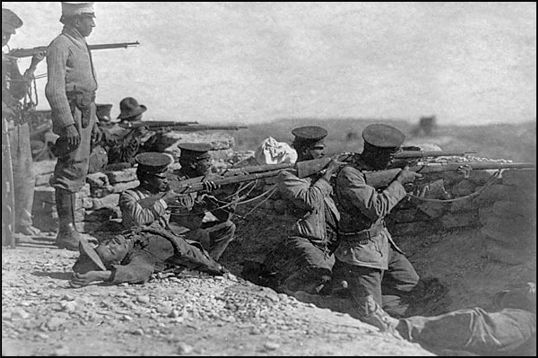
Mexican troops defending Ecatepec de Morelos
It was a disaster. Of the American troops participating in the attack, nearly a third became casualties (22000 troops wounded or killed) and the rest are beaten back in disarray. The Americans attacking Ecatepec de Morelos not only had less troops than those attacking Tlalpan, they also had less support in the form of artillery and reconnaissance. Bullard's decision to put so little troops in Ecatepec de Morelos has been a subject of much controversy among military historians, some saying it was completely his fault and some saying he was provided with bad intelligence. Nevertheless, it ended in a defeat. The two battles would leave another 15000 American troops dead and two more Mexican cities in ruins.
The defeat in the north would force Bullard to reconsider and modify his strategy. The backdoor into Mexico City had been slammed in his face. As a result of the battle, Bullard decided to surround both Ecatepec de Morelos and the capital, hoping to wipe out the Mexican army in central Mexicoand end the horrific war. Bullard wouldn't finish fully surrounding the cities until 21 June 1917, as he was forced to take a significantly larger area and defend from any potential Mexican counterattacks. Despite this, Mexico City would be fully surrounded some three weeks after the "twin battles", as they were called. On 1 July, President Woodrow Wilson offered to open negotiations with the Mexican government. Emiliano Zapata recommended they except, but President Madero refused. Meanwhile, Gomez and Villa's forces were on their last legs.
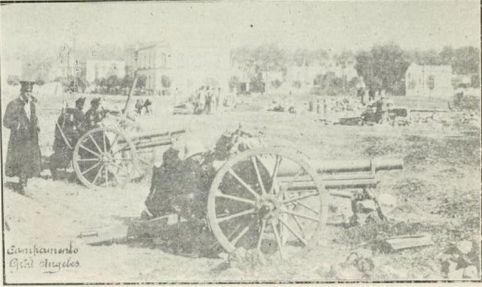
Mexican artillery in Mexico City
Retreat
On 9 July 1917 Dodd and his troops had begun marching across Mexico, pursuing the retreating Mexican forces. Gomez kept this retreat going until he reached Durango, a city that was capital of the provinces of the same name. It was some ways southeast of Hermosillo and northwest of Mexico City. Its official name was Victoria de Durango, named after the first president of Mexico, Guadalupe Victoria. Gomez and Villa placed around one hundred ten thousand troops north of the city in defensive positions to attempt to beat back the 250,000 Americans under Dodd's command. Gomez's men did their best to construct makeshift fortifications, including trenches, barbed wire, and even some pillboxes made out of wood.
Gomez was committed to bloodying the Americans as much as possible, and Dodd seemed happy to oblige him, ordering an immediate frontal attack against the Mexican lines. The reasoning for this is unclear but it seems that Dodd thought the Mexicans weaker than they really were. The American troops took heavy fire charging towards the enemy lines, and many were cut down by machine gun fire before even reaching the Mexican fortifications. American artillery bombarded Mexicans lines all the way up until the points the US troops reached them. This has little effect, however, as most of the Mexican forces were safe from shrapnel and were killed only by direct hits.
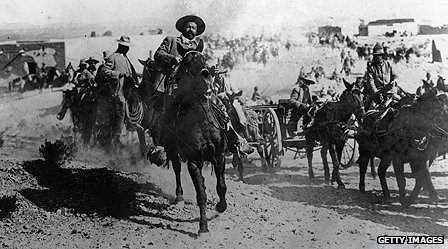
Pancho Villa shortly after the retreat from Durango
Several breakthroughs are made across the lines, and some of the Mexican troops begin to panic, thinking this will be another American victory in a string of American successes. However, seemingly at the last second over 15000 fresh reserve troops, directly under the command of Villa, counterattack. The counterattack throws the Americans back, smashing through their lines and sowing confusion. Dodd's troops are forced to fall back to American lines, and Dodd reconsiders his plan of attack, hoping to use his numbers to his advantage and simply surround Gomez's force, maybe even taking them out of the war completely.
Of course, Gomez was no idiot, and could see the prospective encirclement just as easily as Dodd could. During the night he ordered his entire army to leave the area and march for Mexico City while Dodd was allowing his troops some much needed rest before an attack planned for an hour before dawn. They leave behind only 6000 dead, while Dodd has lost nearly 15000, and lost even more wounded. Despite the heavy casualties, Dodd decides to pursue the Mexican forces and maybe even link up with Bullard around Mexico City, leaving Brigadier General MacArthur to occupy Durango. Tragically, a force of nearly nearly 500 Mexican militia attempt to bushwack his forces in Durango, causing MacArthur to overreact and order a shelling of the city. Several thousand Mexican civilians are killed, and much of the architecture Durango is known for is damaged or destroyed, including the Palacio de Gobierno, which takes heavy damage, and the Catedral Basílica Menor, which has one of its two towers knocked down.

Shell damage in Durango
Final Assault on Mexico City
By 20 July 1917 Mexico City had been under siege for nearly a month. The Americans began to use new tactics as they built up their forces outside the city. One of these new tactics was concentrated bombing against enemy targets. The largest aircraft raid in the war came on 20 July when over 50 US aircraft flew over Mexico City, bombing and strafing the troops in the streets. This managed to disrupt Mexican supplies even further. By this point, ammunition was only readily available for rifles and some machine guns. Still, the Mexicans managed to inflict a heavy toll on the Americans as skirmishing continued throughout the month of July. Another new US tactic was the use of tanks, for which, by 20 July, already 100 US Ford 3-ton tanks were in the vicinity, and more were being manufactured. The US government had ordered the building of nearly 10,000 of the machines, which were designed with mass production in mind.
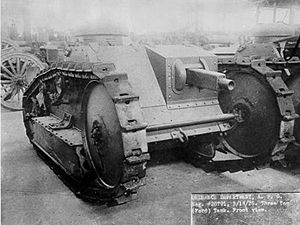
US Ford 3-ton tank
Finally on 7 August 1917 Gomez's army retreated into the area south of Mexico City, bringing Dodd's forces into play in the siege of the capital. Gomez's forces quickly became trapped by American forces as there was really nowhere left to retreat. The Tehuacan valley and state of Veracruz were locked down, Mexico City was surrounded, most of the North was under occupation, and small American forces had begun taking the South, starting with the Yucatan Peninsula. On the same day that Gomez was finally trapped, Wilson sent Madero a final offer of surrender. Despite repeated urging by military commanders, including Zapata, Madero again refused to surrender. Plans were swiftly set into motion for the assault on the Mexican capital and the defeat of the nation.
On 9 August 1917 a prolonged artillery bombardment began, striking all along the Mexican lines and heavily demoralizing both the civilian populace and the Mexican infantry. The real attack began on 12 August 1917, although several feints by US forces had succeeded in letting Bullard and Dodd gauge the enemy defenses. The attack was spearheaded by nearly 500 of the new Ford 3-ton tanks, which were invaluable in the battle, even if they were a bit flimsier than the army wished, and wouldn't likely have held up in the face of determined resistance by enemy armor. Luckily, the Mexicans at this point had only a very small amount of artillery, and had never had any tanks. At the same time as the assault on the capital, Dodd attacked Gomez's entrapped troops.
On 13 August 1917 Gomez surrendered his battered command, now down to only around 50,000 undersupplied and demoralized infantry. Pancho Villa was forced to escape the surrendering army with a small guard of former Zapatistas, as he knew the Americans would likely try him for the attacks on border towns if they caught him. He hid in a farm for several days until he was able to join back up with Zapata, who would keep him from the Americans. Meanwhile, the Americans pushed ever further into Mexico City in brutal street fighting. On 14 August President Madero attempted to escape the city, taking along 100 of his best men. He was intercepted and killed however, although the exact circumstances of his demise are unclear to this day. Some historians have even suggested that Zapata had him killed. However it happened, Zapata became President of Mexico on 15 August and immediately signed an armistice with American forces.
The fighting in Mexico City would later be determined to have claimed 49,246 American lives and 153,029 Mexican lives, including civilian casualties. It was the bloodiest battle of the war by far and absolutely shocks the American populace. Days after the signing of the armistice one American senator was actually heckled off the floor when he suggested helping "America's friends in Europe", referring to the Entente powers. Americans are clearly not interested in yet another war so soon after the last one, especially since guerrilla warfare continues in occupied territory even if all hostilities with the Mexican federal government have ceased.
On 7 September negotiations begin in the city of Veracruz between the American and Mexican governments and on 5 November 1917, the treaty of Veracruz is signed. Mexico cedes both the state of Veracruz and the Baja peninsula to the US. Mexico recognizes the US right to garrison border towns in order to prevent incursions into US territory by Mexican raiders, and also the US right to send troops into Mexico to fight rebels and help quell insurrection. This part of the treaty was actually kind of favorable towards Zapata, as the US would help him beat down any prospective rebel forces, meaning that Zapata would be undisputed in his claim to the Mexican presidency. In addition, Mexico will pay 10 billion US dollars in reparations for the war. This treaty finally ended the Second Mexican American War (23 August 1916 - 16 August 1917). The war cost 137,915 American lives and 337,785 Mexican lives, including over a hundred thousand civilian deaths. Mexico had a long path of reconstruction ahead of it, as much of the north had been devastated by the war. Still, Mexico was finally pulling out of 6 years of almost constant conflict, and had a bright future ahead of it.
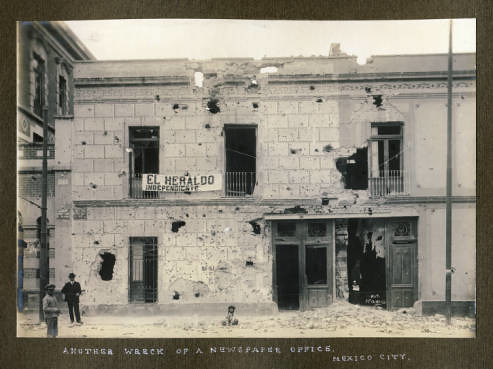
Damage to a newspaper office in Mexico City
Last edited:
that was rather....bloody and violent.
SO, i am curious, are you focusing only on the Americas after this conflict, or are you focusing more or less on the world as a whole, because with no American interference, i could see a Central Powers victory.
SO, i am curious, are you focusing only on the Americas after this conflict, or are you focusing more or less on the world as a whole, because with no American interference, i could see a Central Powers victory.
War tends to be that waythat was rather....bloody and violent.
The world as a whole for sure, and I will indeed be moving into WW1 in my next update. Up till now much of the war has been the same except the allies have less supplies, due to the Americans needing all their supplies for their war with Mexico and the occupation of parts of it.SO, i am curious, are you focusing only on the Americas after this conflict, or are you focusing more or less on the world as a whole, because with no American interference, i could see a Central Powers victory.
Cuāuhtemōc
Banned
This is a pretty interesting read. A shame that Mexico lost though at least the Americans had a bloody nose fighting the Mexicans. I wonder what happens in Europe without American funds helping them.
RamscoopRaider
Donor
Most likely the Entente will be suing for peace soonThis is a pretty interesting read. A shame that Mexico lost though at least the Americans had a bloody nose fighting the Mexicans. I wonder what happens in Europe without American funds helping them.
I'm surprised Mexico did as well as it did given its lack of heavy weapons and other factors
Still I can accept it without problems, though if Mexico did too much better my suspension of disbelief would start wearing thin
Why did we not take more of Mexico in the treaty? Baja only has so much actual worth compared to some of the other areas, and is the state of Veracruz taken similar to the borders that it has now or did they change?
The state of Veracruz is similar to the borders it has now, if a little bit more rounded out. We took Baja mainly more for its value as giving us more ports in the Pacific than anything else. Other than that, there's no point in taking more territory from Mexico. We certainly don't need it, and it would just lead to a bloody occupation.Why did we not take more of Mexico in the treaty? Baja only has so much actual worth compared to some of the other areas, and is the state of Veracruz taken similar to the borders that it has now or did they change?
Form a U.S. client state out of it might be possible? A buffer between us and them? Don't know if that would work, but its a thought.
Just asking questions to see another point of view and learn.
Just asking questions to see another point of view and learn.
It saddens me to see Mexico lose more to the Americans, but this was still a fascinating read! You're alluding to a bright future for Mexico, as well as placing Zapata in charge of the country certainly make me a happy panda though, so consider me subscribed and itching to read more! 
Well the US is allowed to occupy Mexican border towns, so they created a sort of buffer, just not a US client state.Form a U.S. client state out of it might be possible? A buffer between us and them? Don't know if that would work, but its a thought.
Just asking questions to see another point of view and learn.
Thank you!It saddens me to see Mexico lose more to the Americans, but this was still a fascinating read! You're alluding to a bright future for Mexico, as well as placing Zapata in charge of the country certainly make me a happy panda though, so consider me subscribed and itching to read more!
Yeah you're right, I missed that.The posting "A Good Long Look" has a dividing line between Northern and Southern Baja. As far as I can tell, that line doesn't exist until 1930.
Share: